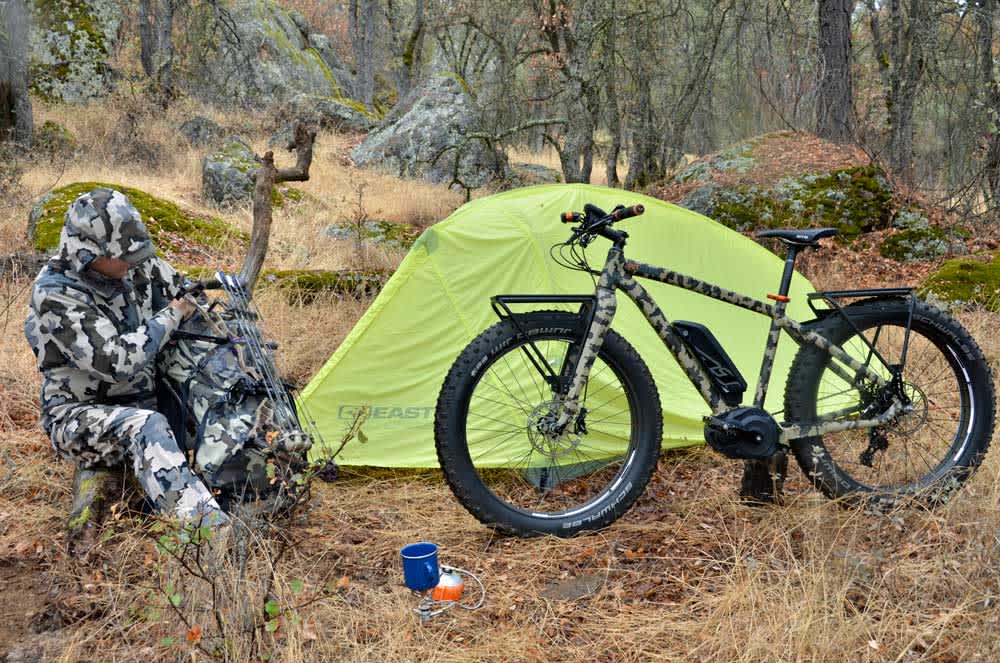Backcountry Hunting on Fat Tire Bikes
Bernie Barringer 06.03.16

Having been around the business of bowhunting for more than 40 years, I have seen some products, ideas and concepts come and go. A lot of them. Some of these things become important parts of bowhunting success for many archers, some find a small niche and move along with the growth of the industry, and, of course, some are relegated to the ash-heap of history. The ones that survive seem to be products that fill a need.
Mountain bikes have occupied a small niche in bowhunting for many years, but they have never gone mainstream. These bikes are not made for hunting and therefore must be modified, and their use is limited to certain terrains. That said, the growth in popularity of fat tire bikes has been quite remarkable, and I suppose it was only a matter of time before they made a serious move at the hunting market.
As these fat tire bikes have showed up at hunting shows over the last year, I have viewed them more with curiosity than anything, but I as I considered how they might fit into my bowhunting, I am about to take the plunge. I bowhunt whitetails on public land in several states each year, and that often involves getting way back into a property to get away from the crowds. For example, I have found a location where I have killed a couple of mature bucks on public land in Kansas, but it’s a walk of more than 1.5 miles. That’s a long haul before daylight and after dark. Once I shoot a big buck back in there, the distance seems to become even longer.
As I thought about this location and several others I have hunted, I began to realize that most of the properties I hunt have a network of access roads that are used by the DNR, and sometimes by farmers who have agreements to plant crops on the property. On that 1.5-mile trek, more than a mile of it could easily be ridden on a bike.

The advantages of fat tire bikes are many. You can ride them over rough or muddy ground, even snow. They are geared for rough terrain and provide good traction and balance. They will ride right over small obstructions such as branches and rocks, obstacles that might trip up a normal mountain bike. These bikes are built to take the beating a hunter will dish out.
Three of the major players in the fat tire hunting bikes are Felt, Rambo and Cogburn. Each of these offers accessories that make the bike useful for hauling hunting gear. This includes racking, bow and gun holders, trailers, bags, lighting and fenders.

Rambo and Felt offer bikes with electric assist motors. The lithium ion batteries give you speeds of up to 20 mph and will travel 19 miles between charges on motor use alone. You can use the motor as a pedal assist if you like, which will give you even more distance on a battery. Sweating up a steep hill? Just switch on the motor for some assistance. There is some question about using the electric power on properties where no motorized vehicles are allowed, but a representative from Rambo told me the bike has been okayed by several state wildlife agencies.
A couple of issues I see with the use of the bikes: First of all, once I arrive at my treestand, I need to find a place to hide it so it doesn’t attract the attention of deer. Secondly, when I have a lot of gear to haul in and out, will the bike and trailer be able to handle it all? Will I be able to pull a deer out with the bike, or will it mean one more trip back and forth to my truck?
After using a bike for this upcoming season, I should have a lot better feel for how these questions will be answered. At this point, I can see all kinds of applications for them in scouting, checking game cameras, plus getting to and from a treestand. The advantage of being able to get around much more quickly could be huge.
Here are two more advantages I see: One is the reduction in scent impact when travelling in my hunting area. My boots are not touching the ground, and I will be moving faster, leaving less signs of my intrusion that might alarm deer. Secondly, I ride a bike quite a bit on trails through wooded areas near my home, and I see that deer react much differently to a person on a bike than they do to a person on foot. They don’t see a person sitting on a pair of wheels as nearly the threat that they perceive a person walking. I’m not sure how much that will be an advantage, but spooking deer while scouting and travelling to and from a hunting location could be reduced.
While my first reaction to the surge in fat tire bikes made for hunting was one of curiosity, that has turned to excitement for trying out this new mode of transportation. Will this be another of those trends that ends up as a bit of hunting history, or will they find a niche that offers long-lasting usefulness? Speaking as a DIY bowhunter, let’s hope it’s the latter.


